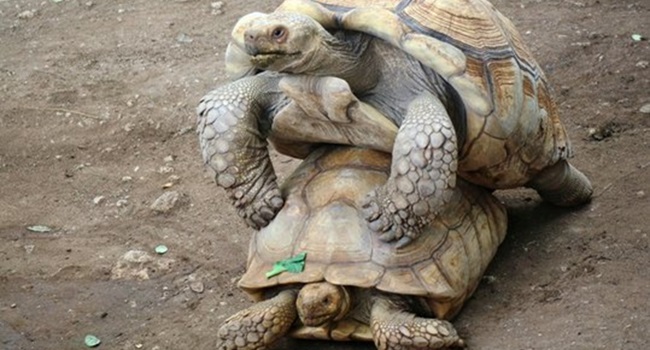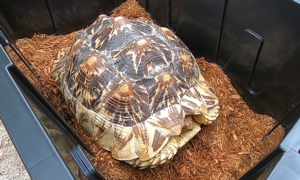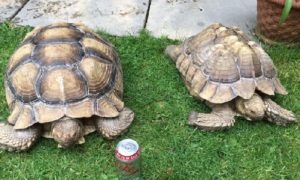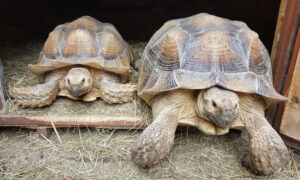The mating behaviors of sulcata tortoises includes courtship, mating and nesting. Both the male and female sulcata tortoise play a role in ensuring the most successful reproduction of their species.
Courting Female Sulcata Tortoises
The mating process starts when a male sulcata tortoise begins courting a female tortoise. The courtship behaviors of male sulcata tortoises typically include a combination of visual displays, vocalizations and physical interactions. The courtship behaviors of tortoises help strengthen and establish the bond between the male and female sulcata.
Typically, the male sulcata will approach the female tortoise. He may follow her or circle around her to get her attention. The male tortoise may make low sounds to get her attention, as well as nudge or bob his head, which clearly tells the female what his intentions are.
The female sulcata tortoise may also circle the male or nudge him to show her interest.
Sulcata Tortoise Copulation
When both male and female sulcata tortoise have essentially agreed to the mating, the male will mount the female, aligning their cloacas.
The actual copulation process can take anywhere from several minutes to and hour or more.
The male tortoise may make sounds during the mating process. The female tortoise may make slight head or limb movements. The sulcata tortoise mating dance is crucial to ensuring successful mating.
Sulcata Tortoise Reproduction
Mating behaviors of sulcata tortoises are solely to enhance their changes of reproductive success. If available, the male may choose more than one female to mate with. Often times, when in groups, the male will have a favorite female, but he will still mate with others.
Female sulcata tortoises will store sperm for long periods of time to ensure when she lays her eggs, it is during the best weather season to ensure a higher hatch-rate. She can actually store enough that she can lay several clutches of fertile eggs.
Nesting and Egg Laying Behaviors
The female tortoise will begin building her nest when she deems the weather and other factors are optimal. Typically, she will gestate for 90-120 days before building her nest. She’ll seek a location, possible test digging several before deciding on the final location for her nest. The female sulcata will dig a hole deep enough to protect the eggs from predators and major temperature fluctuations.
Female sulcata tortoises lay between 15-20 eggs per clutch.
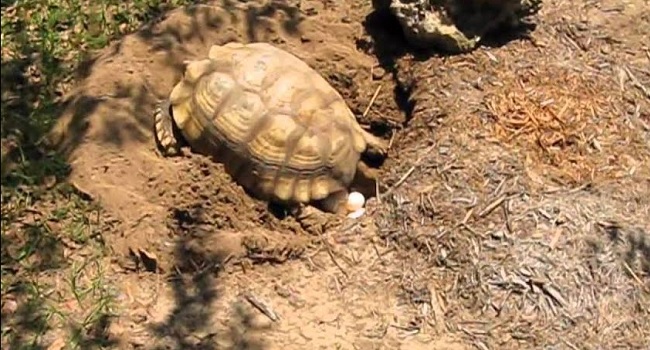
What Influences Sulcata Tortoise Mating Behaviors?
There are environmental factors that influence mating behaviors of sulcata tortoises.
Being highly attuned to the weather and seasonal changes, the mating activities often coincide around the weather. The mating process and courting will likely begin with increased rainfall to improve foraging availabilities. Rain encourages vegetation growth for food resources, as well as creates optimal nesting conditions.
Mating behaviors of sulcatas are more common during warmer months when the tortoises are more active.
Negative Factors that Effect Sulcata Mating Behaviors
In the wild, sulcata tortoises have to navigate the challenges of their natural environment, human activities pose significant threats to their mating behaviors and overall reproductive success. Habitat destruction, driven by urbanization and agriculture, can disrupt the natural nesting sites of these tortoises. Pollution and the introduction of invasive species also contribute to the degradation of their habitats.
In captivity, improper husbandry practices and inadequate environmental conditions can negatively impact the reproductive behaviors of Sulcata tortoises. Stress induced by overcrowded enclosures, poor nutrition, or suboptimal temperature conditions can interfere with the mating process and reduce the likelihood of successful reproduction.

